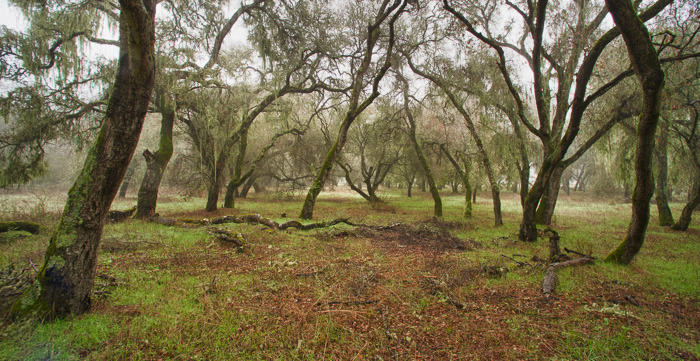In the preceding post and an earlier one, a reader proposed an ETTR technique that I will summarize in Zone System terminology: Place the brightest significant highlight on Zone VIII. A simple way to achieve this is to set the metering mode on a (Nikon — see the comment for Canon technique) DSLR to spot, set the exposure compensation to +3 stops, set the exposure mode to manual, point the camera at the brightest significant highlight, adjust the aperture and shutter speed to null the meter, reframe the image, and press the shutter release.
No messing with histograms. No fiddling with the white balance. No looking at EXIF data. All good things. How well does it work?
The first test I gave the technique was this scene:
It’s a toughie for exposure. The dynamic range is great; you’re actually looking at an image constructed from five exposures a stop apart. The brightest spot in the image is in the upper part of the sky, which is well off center, so it will be darker than if it were in the center of the image (where the spotmeter reads) due to the falloff of the light from the 14mm f/2.8 Nikkor. Well, the stars all aligned, and the highlight on Zone VIII technique yielded the same exposure as the corrected in-camera histogram approach.
So I moved on to other subjects, still using the 14mm on the D4. Sometimes the two exposure techniques agreed. Other times, the spotmeter method told me to use a third of a stop or a half a stop more exposure than the in-camera histogram. The results in these cases were closer to the right hand side of the histogram than I usually like to see, but the highlights were not blown. You could argue that the spotmeter method produced more optimal exposures.
Here’s one such image:
Here’s the real raw histogram:
I moved on to the Leica M9, which has no spotmetering capability, so I had to make some adjustments. I used the D4 with a Zeiss 100mm lens as a spotmeter. I got inconsistent results; some good, some underexposures, and some with blown highlights. I think the combination of the tight spot on the D4 and the longish focal length probably gave me such a small light sensitive area that it really needed to be pointed at the exact right place.
My next test case was the Sony NEX-7 with the Zeiss 24mm lens. It was a total flop. The camera doesn’t let you apply exposure compensation in manual mode, choosing instead to show you how far over or underexposed you are. Not a bad plan, right? Maybe for most purposes, but the range of the under/over exposure indicator is plus or minus two stops, and I needed at least three to make the spotmeter-the-highlight trick work. Could I set the camera to aperture-preferred, set the exposure compensation to plus three stops, meter the highlight, press the exposure lock button, recompose, and trip the shutter? I could indeed, but all the while I was doing this dance, the histogram in the lower right corner of the viewfinder was mocking me, asking me why I was putting myself through contortions when all I had to do was look at it. The pictures confirmed that spotmetering works as well as on the D4, but it’s way more trouble than it’s worth on the NEX-7.
I tried an infra-red modified D3x, and, as expected, the spotmeter technique produced horribly underexposed images. The meter, being in the finder, has no idea that the sensor has been modified.
My conclusions? If you’ve got a conventional DSLR, and find the “shoot, look at the histogram, correct exposure, and shoot again” approach irksome, using the built-in spotmeter and putting the bright highlight on Zone VIII is a fine alternative for ETTR. If your camera doesn’t have a spotmeter mode, like the M9, don’t run out and buy a spotmeter; correct the white balance and use the histogram. If you’re using a camera with an electronic viewfinder that shows you a live histogram, correct the white balance, look at the histogram, and you won’t have to make any trial exposures.
Thanks to my correspondent for bringing this technique to my attention. I’m sure there will be times when I’ll use it.



My correspondent says:
“Minor tweak for the Canon people. Canon’s engineers, in their wisdom, do not allow EC adjustment in Manual mode. So, “nulling” it, is adjusting meter to +3….or whatever your testing determined to be correct. Luckily the newer cameras do have +/-3 in the viewfinder meter.”
Eureka!!!! This is an amazingly simple solution to a problem that has long vexed the photography world.
If everyone applied this technique, it would stop forever the endless internet feuds over how to properly expose a camera.